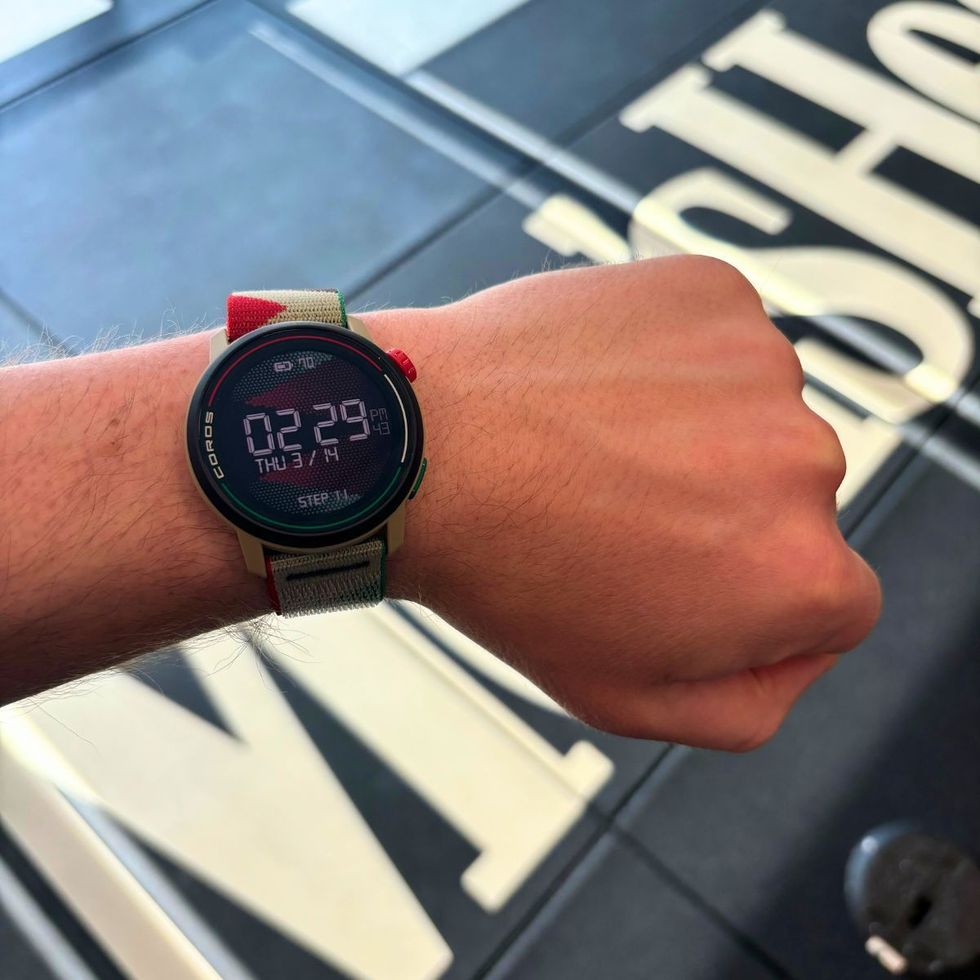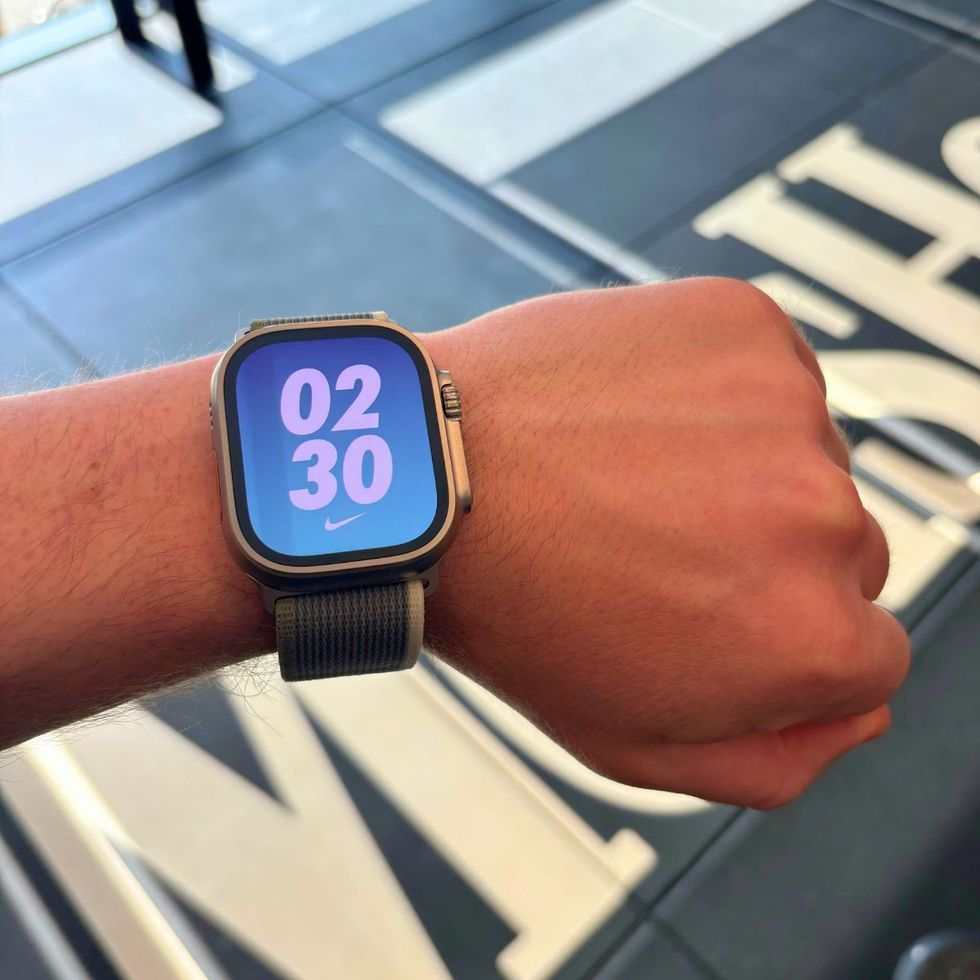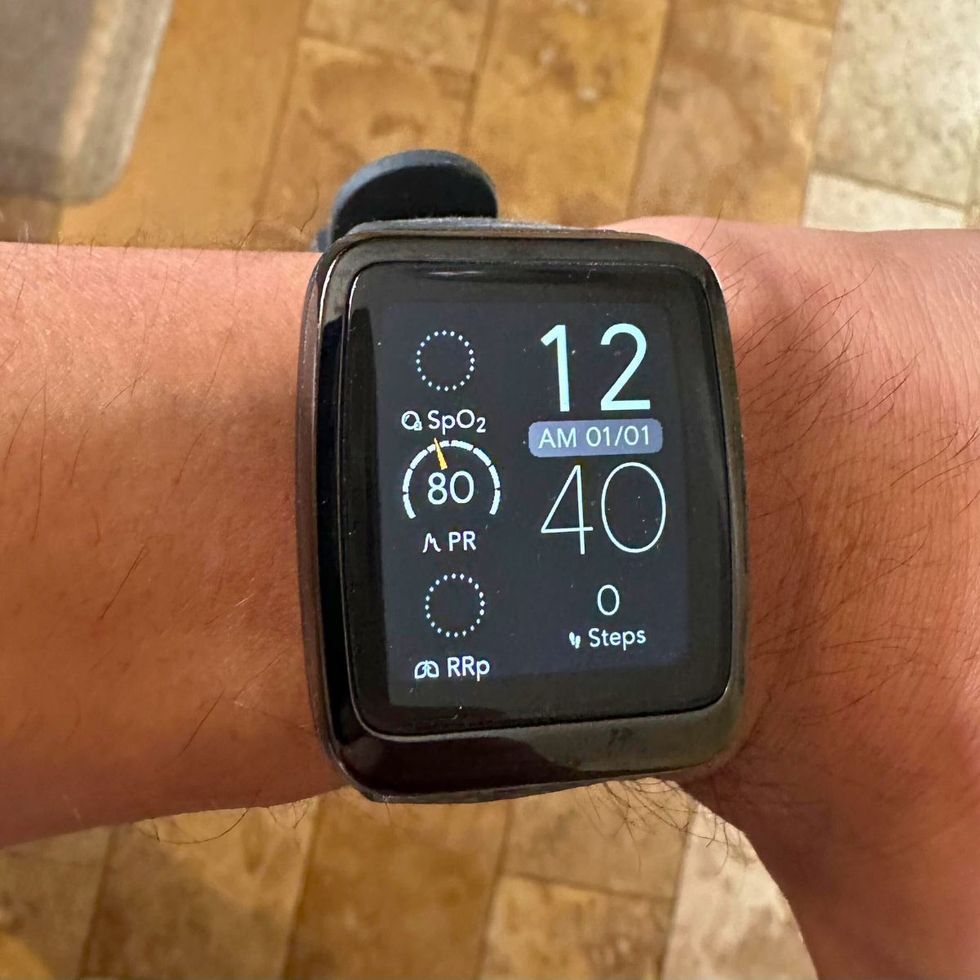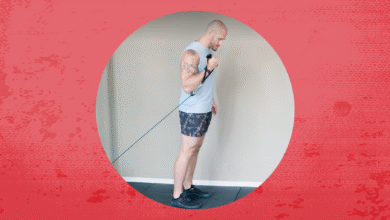6 Best Fitness Trackers 2024: Tested by Our Fitness and Tech Experts
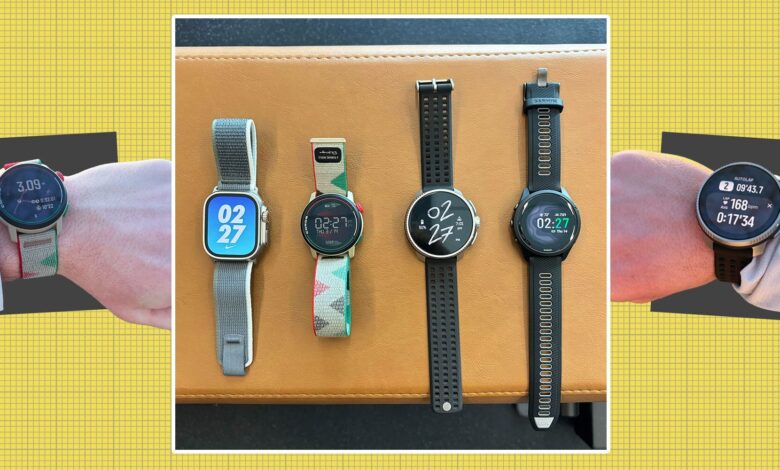
Pros
- Simple user interface
- Comfortable, stretchy strap
- Crisp AMOLED display
- Super lightweight and thin design
- Comes with special features like Training Readiness and Gear log
- Solid feedback on a wide variety of activities, including strength training
- Garmin Connect app is smooth and fun to use
Cons
- Touch screen
- Learning curve when tracking strength training
The Forerunner 265 is about as balanced of a fitness tracker as one can find. It has a beautiful AMOLED display, making it easy to read in all parts of the day (even in direct sunlight). It comes in a 42mm and 46mm size. The Forerunner 265 is also seriously lightweight (well under 50 grams), so you won’t have any concerns about feeling the device on your wrist.
As far as navigation goes, the Forerunner 265 has five clean buttons to help aid in touchscreen navigation. We had trouble at times scrolling on the touchscreen after running in cold and windy weather (it seemed like the screen wasn’t responding to our dry hands), but a quick pivot to using the buttons helped avoid any serious navigation issues. We do like how the Forerunner 265 ditches a scrollable crown; it makes the watch leaner and removes common issues where the crown can catch dirt or dig into the wrist when wearing.
The best part about the Forerunner 265: it’s library of features. You get heart rate variability (HRV), zone training, and even sleep tracking. New to the Forerunner 265 is also Garmin’s Training Readiness, which used to only be available on more expensive Garmin watch models. Training Readiness is fun to have because it takes into account metrics like sleep score, recovery time, acute training load, HRV status, and more to determine when your body is best suited for a hard workout—and when you might need to dial it back for the day so your training doesn’t become counter productive.
The Forerunner 265’s wide array of workout modes you can choose from makes it super versatile. The Forerunner 265 is actually pretty comfortable to wear during strength training. As far as tracking strength training, the device will actually track your different sets and number of reps. Now, the learning curve on programming your strength training is more difficult than we like, but once you learn how to insert your workouts—and once you get in the habit of tapping your watch as you move to your next set—the feature is actually pretty fun to use.
Inside the Garmin app, you have a ton of other interesting features. There’s a section on race training and planning, where you can log your upcoming events and program in your specific workouts. There’s an “Insights” feature which lets Garmin send you motivational messages and training suggestions. Then there’s a “Gear” section, a feature we especially loved testing, where you can log in products like your running shoes and track how many miles you put into them before you need a new pair (we reported a good rule of thumb to replace your running shoes is between 300-500 miles).
The Forerunner 265 is your all-around player to helping achieve your fitness goals. Look here first before you start examining other fitness trackers.
Read more: Best Gadgets on Amazon
| Weight | 47g |
|---|---|
| Battery Life | Up to 13 days in smartwatch mode. Up to 20 hours in GPS mode |
| Water Resistance | 50m |
| Sizes Available | 42mm, 46mm |
| Satellite Systems | Garmin Multi-Band GPS |
| Sleep Tracking | Yes |
| Warranty | 1 year |
Pros
- Crisp AMOLED display
- Massive battery life for a smart watch of this caliber
- Clean user interface
- Connected app is simple and easy to navigate
- Cool, rugged style
- More comfortable strap than the Forerunner 265
- Precise GPS tracking makes it suitable for hiking and trail running
Cons
- Screen size and weight might be too bulky for some
- We recommend buying the titanium edition for $100 more to help cut down on watch weight
Big, bright, and packaged in a cool, rugged style: that’s what we noticed at a first glance when testing the titanium edition of the Suunto Race. For years, Suunto has been making great fitness trackers and outdoor watches, but after testing the Race we believe this is the best Suunto device we’ve ever tested.
For starters, Suunto did not try and go toe-to-toe with Garmin on packing in a ton of features, which is a good thing. Instead, the Suunto Race delivers core features like heart rate variability (HRV), GPS tracking, zone training to determine workout intensity, and Vo2 max estimates. The Suunto app if straightforward and easy to navigate all this captured data. As for the user interface of the watch, we found no issue with lagging like other fitness trackers sometimes have.
Our two favorite highlights from the Race’s software includes the GPS system (the Race connects to 5 satellite systems to track your routes in crowded cities and outdoor trails), and the zone training readings (this is especially useful to have if you are focusing on zone 2 training).
Here’s where the Suunto Race sets itself a part from other fitness trackers: it’s physical design. We tested the titanium case edition of the Race (which is an extra $100 in price), but if we had to choose again we would recommend the titanium over the stainless steel due to the lighter weight (the titanium edition weighs 69 grams compared to the stain steel’s 83 grams). Suunto added a bright AMOLED touch screen to its 49 millimeter case size to take the watch to the next level in terms of visibility and crisp graphics. The last great feature of the Suunto Race is its battery. It can pack up to a 40 hours on Performance Mode (heart rate and GPS turned on), and up to 26 days in Standby Mode (heart rate off and no training).
The Suunto Race is a rugged fitness tracker with high durability, clean user interaction, and solid instruments. You can use it for multi-sport training, outdoor activities, and even strength training. When you’re not working out, you can toss it on your wrist and get some cool style points out of it.
| Weight | 69g |
|---|---|
| Battery Life | Up to 40 hours in Performance mode. Up to 5 days in Tour mode. Up to 26 days with daily heart rate off. |
| Water Resistance | 100m |
| Sizes Available | 49mm |
| Satellite Systems | GPS, GLONASS, GALILEO, QZSS, BEIDOU |
| Sleep Tracking | Yes |
| Warranty | 2 years |
Advertisement – Continue Reading Below
Pros
- Light as a feather (lighter than the Forerunner 265)
- Perfect for running
- Simple user interface and button navigation
- Cool watch designs to choose from
- Awesome price point
- Useful weather widget that provides hour-by-hour forecasts
- Reliable GPS tracking
Cons
- Has a touchscreen, but really it’s best to navigate with its button
- LED screen isn’t as bright and vibrant as AMOLED
The Coros Pace series has been one of the best bang for your buck GPS fitness trackers for a few years now. The latest Pace 3 watch is our definitive best value pick in 2024 thanks to its featherweight design, reliable readings, and simple user interface.
On design, the Pace 3 pairs its lightweight build with some of the longest battery life out of the fitness trackers we tested; we’re talking 30 hours of use in GPS mode and over two weeks in its basic mode with GPS turned off. The Pace 3 does have a touchscreen interface that we found works pretty well for being such a small screen, but really this is a watch best navigated by its buttons (the scrollable crown is smooth and responsive).
There aren’t a ton of features on the Pace 3, but there are definitely enough to make it worth the buy. You have essentials like heart rate monitoring (with zone heart rate training breakdowns you can access in the app), and GPS tracking for route running. The watch also comes with a barometric altimeter to provide elevation data, which is fun to use when trail running. One of our favorite features to use on the Pace 3 was installing the weather widget. The weather widget sources data from Apple Weather and provides a mapping of hour-by-hour weather on your watch, making it useful on days when you are dealing with intermittent bursts of rain.
The two biggest downsides of the Pace 3 are its plastic construction and its screen brightness. The durability of the plastic is actually pretty tough, and even protective up to 50 meters when exposed to water. However, the plastic is still more susceptible to cracking or damage than a stainless steel or titanium fitness tracker would be (the tradeoff between these materials though, is the plastic construction makes the Pace 3 lighter). On screen brightness, the Pace 3 gets by on visibility for both day and night, but after we tested fitness trackers with AMOLED, it became pretty hard adjust back to a downgraded screen (the Pace 3 has a color LCD screen).
Last note we’ll add is the user experience. The Pace 3 is a fun watch that doesn’t try and do too much. In fact, its perfect if you are looking for an entry level fitness tracker or if you want a device that won’t break the bank. The Pace 3 will still deliver notifications from your phone to wrist, so you won’t be in the dark on texts or calls (the device won’t make calls, though). The Pace 3 includes several different digital watch face designs you can apply. Coros even has several different models of the Pace 3, with nylon band and silicon band offerings that are more unique than other fitness trackers you can find. To illustrate Coros’ availability of cool designs, we asked to test the special edition color made for professional runner Ellud Kipchoge.
| Weight | 30g |
|---|---|
| Battery Life | Up to 17 days in smart watch mode. Up to 38 hours in GPS mode |
| Water Resistance | 50m |
| Sizes Available | 42mm |
| Satellite Systems | GPS, GLONASS, Galileo, Beidou, QZSS |
| Sleep Tracking | Yes |
| Warranty | 2 years |
Pros
- Sleek adventure watch design
- Can be used as a dive watch up to 100 meters
- Great for everyday use
- Siren for emergencies and water temp sensor
- Highly underrated durability
- Especially fun to use for strength training
Cons
- Popular colors sell out fast
- Battery life not as long as other outdoor watches
- Blood oxygen monitoring removed for the time being
With a starting price of $799, the Apple Watch Ultra may seem pricey, but it’s not really outlandish compared to other devices in the same tier. In fact, one can argue the Ultra is in a class of its own, blending the superior day-to-day use of an Apple Watch with rugged specs one might see on the most expensive Garmin and Suunto watches. It contains the same new features as the Apple Watch Series 8, plus a few more. You get a bigger watch face, a seriously strong titanium frame, boosted battery life, and 100 meters of water resistance.
After wearing the Ultra for over a year now, we’ve noticed it reacts quite well to nasty falls and dings. It’s fallen from shoulder high and smacked right into concrete and come away unscathed. It’s also come in contact with an olympic barbell from time to time. None of this means you shouldn’t remember to flip your Ultra face to the inside of your wrist before a set of kettlebell cleans, but you do get peace of mind knowing that this watch can take a pounding.
The Ultra delivers a bigger screen than a Series 8, a unique Wayfinder face with a live compass, a siren for turning on in emergencies, a water temperature sensor, a depth gauge, and an upgraded speaker and microphone setup. The Ultra’s biggest win, though, is (you guessed it) its ultra-seamless link to iPhones. Nothing beats the easy pairing (and later, data sharing) that can take place between any Apple Watch and an iPhone. We’ve come to trust the Ultra for occasional everyday wear, traveling, and fitness.
| Weight | 61g |
|---|---|
| Battery Life | Up to 36 hours |
| Water Resistance | 100m |
| Sizes Available | 49mm |
| Satellite Systems | Dual-frequency GPS |
| Sleep Tracking | Yes |
| Warranty | 1 year |
Advertisement – Continue Reading Below
Pros
- Superior metric tracking, especially when it comes to heart rate
- Innovative features like Hydration Index and blood oxygen sensors
- Display is simple and easy to read
- Generous warranty
- Connected app provides easy reading of data
Cons
- Doesn’t have music storage or phone notifications
- Barebones design
The Masimo W1 is a favorite of MH fitness director Ebenezer Samuel, and it’s increasingly brought up in our office conversations. Why? Because he’s found it to be the most accurate tracker on the market. During testing, Samuel wore both the W1 and a pulse oximeter similar to those used to track heart rate in hospitals. The W1 was within two beats per minute of the pulse oximeter at all times. (Another popular fitness tracker was often 10 beats per minute off from the oximeter during the same test.) “The W1 is the most accurate smartwatch I’ve ever used, period,” says Samuel. It’s also forward-thinking, aiming to track your hydration levels via a suite of Hydration Index stats.
The W1’s ultimate calling card, though, is its tremendous accuracy. Typically, if you want the most accurate heart rate readings during a run or training, you’d want to don a wearable heart rate strap around your torso. The W1’s pinpoint accuracy changes that.
Unfortunately, the W1 doesn’t do much else: it has zero ability to download or listen to music and doesn’t send phone notifications. It’s also $500, which is a steep price for a fitness watch. Thus the ultimate decision on the W1 comes down to how serious you are about tracking your fitness, and how little you care about special features or sleek and sexy watch design.
Thankfully Masimo has a few releases up its sleeve in 2024. We’re hoping they roll out some more user friendly fitness trackers that do more than just provide hardcore accuracy, but, if not, we won’t be complaining.
| Weight | 34g |
|---|---|
| Battery Life | Up to 24 hours |
| Water Resistance | 50m |
| Sizes Available | 40mm |
| Satellite Systems | None |
| Sleep Tracking | Yes |
| Warranty | 3 years |
Pros
- Surprisingly durable thanks to sapphire glass screen and titanium case
- Seamless compatibility for Android users
- Body composition data can be useful to get estimated readings of body fat
- Sleep coaching feature can be useful to some
- Solid value for the price you pay
- Tons of case colors and band designs to choose from
- Upgraded GPS and a new voice navigation feature
Cons
- Battery life can fluctuate from watch to watch
- Not ideal for iPhone users
No iPhone? No problem. The Galaxy Watch 6 can go anywhere thanks to a large scratch-resistant screen and a strong titanium case. Our favorite features include advanced sleep coaching that analyzes your sleep habits and suggests what you can do to improve, as well as a body composition reader. In just a few seconds, the Galaxy Watch 6 works to tell you your vitals (it even provides a body fat estimate). These stats are prone to inaccuracy (few home devices can accurately track body fat), but we give props to Samsung for trying to push metrics to another level.
The Galaxy Watch 6 also delivers the features you’ve come to expect in high-end smartwatches. That means accurate GPS specs and voice navigation. Nailing these features (as Samsung does) is extra-critical in 2024, in part because the Galaxy Watch 6 actually has some new competition for Android users (namely, from Google’s Pixel Watch).
The Galaxy Watch gets the edge as our preferred pick for Android owners thanks to several generations of trial and error. The array of features available and the materials used to craft the watch have been optimized a few times over, thus producing a seriously strong, long-lasting fitness tracker (and everyday smart watch) most users will be happy adding to their training arsenal.
| Weight | 33g |
|---|---|
| Battery Life | Up to 24 hours |
| Water Resistance | 50m |
| Sizes Available | 40mm, 44mm |
| Satellite Systems | GPS |
| Sleep Tracking | Yes |
| Warranty | 1 year |
Advertisement – Continue Reading Below

More Factors to Consider
Aside from looking at accuracy, battery life, and durability, there are a few more key factors you can look at before buying a fitness tracker.
Weight
A lightweight fitness tracker feels amazing on the wrist. For activities like running, biking, and swimming, the lighter the fitness tracker, the better. The Coros Pace 3 and the Garmin Forerunner 265 are two of our lightest fitness trackers we recommend.
When it comes to strength training, hiking, trail running and more, a fitness tracker with strong materials that prioritizes durability might be a better choice. The downside is some of these watches are heavier than some might prefer. Our hack? Opt for spending more if there’s a lighter metal available—like with the Suunto Race titanium edition versus the stainless steel.
Music Storage
A handful of our fitness trackers above come with memory to store music offline. This is a great feature to have if you like to use your fitness tracker without your phone nearby. Consider the amount of memory in your fitness tracker if you like to listen to music offline, without using data to stream from your preferred music app.
Sleep Tracking
A lot of the latest fitness trackers (and smart watches) are coming with sleep tracking features. We’ve written about sleep trackers a number of times. We like the tech, but it’s important to note sleep trackers will not improve sleep. They will just provide you with data to interpret your sleeping patterns and make adjustments (which can be a huge payoff for some).
Some of our fitness trackers include sleep tracking data in recovery scores and training readiness scores. The main example of this would be in the Garmin Forerunner 265’s Training Readiness feature, since sleep history is one of the metrics Garmin notes it uses for calculating this score.
Buying the Latest Model
Choosing the right fitness tracker comes down to getting the features you need at the right price, so yes, we took price into consideration, too. You’re always deciding between price and features when you deal with tech, though. Just remember: In theory, you’ll be with your news smartwatch for a year or two, so it may not be a bad idea to purchase something a bit more cutting-edge, so you can get more mileage out of your device.

Are Fitness Trackers Worth the Money?
As long as you understand that a fitness tracker should not dictate your performance during your workout, then a fitness tracker is definitely worth the money. Some individuals (including ourselves from time to time) can get caught up in looking at our fitness tracker during our workouts, but it’s important to know these devices aren’t accurate like medical devices.
Instead of focusing so hard on the numbers, ask yourself if you are feeling stronger and do a check on how your body feels the next day. Make sure to finish your workout too (you don’t want to be falling short of a workout just because your fitness tracker was over programmed to make you burn more calories than you need).
If you use your fitness tracker as a supplementary tool to gauge your performance, then you’ll put yourself on the right track to potentially optimizing your health to a whole new level.
Advertisement – Continue Reading Below

Ebenezer Samuel, C.S.C.S., is the fitness director of Men’s Health and a certified trainer with more than 10 years of training experience. He’s logged training time with NFL athletes and track athletes and his current training regimen includes weight training, HIIT conditioning, and yoga. Before joining Men’s Health, he served as a sports columnist and tech columnist for the New York Daily News.


